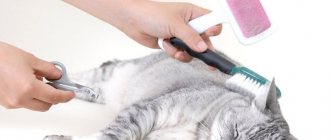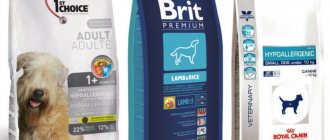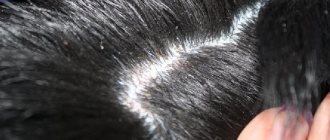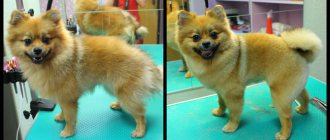People can be very picky about their appearance, spending a lot of time in front of the mirror. Despite this, almost all dog breeders forget that cosmetic problems are not only the prerogative of humans. Similar troubles happen to our smaller brothers. In particular, comedones in dogs are quite typical. Despite their apparent “frivolity,” they can cause a lot of trouble for your pets.
Unlike humans and even cats, where comedones are actually clogged sebaceous glands, acne in dogs can “technically” be considered a manifestation of folliculitis and.
Inflammation of the hair follicle - folliculitis, the process transitions into a purulent form with the formation of pustules - furunculosis. Thus, in dogs this pathology is quite dangerous in itself. If you do not provide timely medical care to a sick dog, the consequences can be very serious.
Comendons “grow” in abundance on the chin and lips
.
Since these areas are covered with short and coarse hair, clinical signs quickly become apparent. Subsequently, the skin in these areas becomes inflamed, swells, and possibly (later) the formation of cicatricial adhesions. In most cases, quite severe skin itching develops, sometimes the dog scratches its face until it bleeds.
It is believed that comedones are quite common in all dog breeds. But in practice, it turns out that more than 70% of cases are diagnosed in short-haired animals. In addition, it is in them that the disease is often most severe, often (and without much delay) progressing to.
Further development of the disease
If you don't take your dog to the vet, things will get much worse:
- Small ulcers and boils burst, the chin area is sometimes completely covered with drying pus and ichor.
- As the animal’s immunity weakens, increasingly larger papules and boils appear.
- Bursted boils and papules do not heal; large ulcers develop in their place.
- Due to pain and intoxication, the animal partially or completely loses its appetite.
Predisposing factors
Unfortunately, there are many dozens (if not hundreds) of causes of comedones in dogs. That is why the primary task of the treating veterinarian is to identify a specific factor in a particular case:
- Injuries.
- . By the way, this is a very common reason.
- Autoimmune diseases.
- Eosinophilic folliculitis and furunculosis.
- Malassezia dermatitis.
- Histiocytosis.
- Metabolic disorders. Let us note that comedones often appear in those dogs whose owners do not particularly monitor the quality of their pets’ diet.
- Neoplasia.
- reactions.
- Secondary staphylococcal
skin lesions. They usually develop against the background of various injuries, accompanied by a violation of the integrity of the skin.
Previously, it was believed that acne in dogs is almost always the result of hormonal imbalances in the pet’s body. But now experts are inclined to believe that it’s all about pathological follicular keratinization, which is characteristic of most shorthaired pores
od. But even among them there are varieties that are at particularly high risk:
Owners should always remember the high likelihood of developing dermatological pathologies in their pets. Take the time to bring them for preventive examinations to experienced veterinarians more often!
List of diseases accompanied by comedones
As we have said many times, dog acne rarely grows on its own. This happens much more often if the pet is already sick with something. Here is an approximate list of diseases accompanied by comedones:
- Pathologies of the thyroid gland . In this case, primary type comedones develop.
- Comedones syndrome , or “schnauzer comedones syndrome,” which we already mentioned above.
- Sebadenitis. Hereditary autoimmune disease. We have already written that pathologies of this type can cause the growth of tumors, but in this case they appear with a 100% probability.
Diagnostic techniques
Everything is quite simple here. Since the symptoms are quite obvious, everything is usually limited to a simple external examination. The owner plays a significant role in this “action”. You must tell the specialist about the dog’s feeding conditions, changes or lack of appetite, diarrhea, vomiting, etc. If you have tried to treat your pet with something, do not be shy - if you tell the veterinarian about it in time, there will be much fewer problems later.
As a rule, specialists take a sample of pathological material in the form of a scraping and/or aspirate (pumping out the contents of the acne with a syringe)
. All this is used for further microscopic examination, or is sown on nutrient media for the purpose of growing a culture of the pathogen.
Therapeutic techniques
Treatment in such cases is (usually) quite simple. The main thing is not to start the pathology before the development of septic phenomena and the need for surgery.
Here are the main techniques:
- Surgical collar.
This, by the way, is very important - a regular “Victorian” collar is a reliable guarantee that an overly “active” dog will not tear his chin to the bones due to itching and pain. Fortunately, the animal will not have to wear it for long: as soon as everything starts to heal and the effect of the medications takes effect, the pet will no longer try to scratch everything.
- Local application of drugs
. Firstly, it is necessary to immediately stop the development of bacterial microflora. Before this, it is necessary to first soften and remove the crusts of dried exudate. The simplest way to achieve this result is to apply antibacterial ointments (tetracycline). But at the same time, you need to strictly ensure that your pet does not lick these medications from his skin!
- Benzoyl peroxide
is also a good solution to the problem. It disinfects the skin well and perfectly washes away excess sebum.
- Oral retinoids
help restore the epithelial layer.
- Corticosteroids
are good at stopping inflammation, but they often cause immune problems in dogs. It is not advisable to use them for more than a couple of weeks.
- In almost all cases, antibiotics and/or antifungal medications are necessary.
The duration of the therapeutic course is up to two weeks. The use of oral antibiotics for dogs is extremely undesirable, since these drugs cause severe intestinal disorders in them.
The skin of hairless breeds requires special care. The Chinese Crested and Mexican Hairless, Sphynx, Hawaiian Hairless are hairless, their skin is rougher, its sebaceous glands actively produce sebum (sebum), which, together with dead cells, clogs the excretory ducts, forming subcutaneous tubercles (comedones). The skin is more susceptible to external influences (sunburn, pollution and injury).
Causes of skin problems
Due to constant licking and injury to the skin with a rough tongue (this applies more to cats of hairless breeds - Canadian and Don Sphynxes), animals may lose the desire to engage in their own hygiene (grooming). As a result, sebum accumulates on the skin with the skin epithelium. Most of this mass is formed in the folds and near the claws. This causes the animals to become oily to the touch and emit a rancid odor. If there is increased secretion of the sebaceous glands, the cat must be washed with antiseborrheic shampoo. And remove accumulations of secretions in claw beds and folds manually. Excessive secretion of the sebaceous glands is one of the signs of internal ill-health: hormonal imbalance (in particular, secretion increases when estrus approaches, with ovarian follicles, with inflammatory processes of the uterus, during active puberty, with adrenal dysfunction, etc.), food and contact allergies . In some cases, improvement may be observed after sterilization. To determine the cause, a consultation with a veterinarian and a general examination of the animal is necessary.
Comedones in cats and dogs
The skin of Chinese Crested and Mexican Hairless dogs and Sphynx cats is prone to the formation of comedones or simply acne. Comedones are clogged sebaceous glands of the skin. Skin cells and sebum form a plug that clogs the excretory ducts and the secretion accumulates inside the gland. Comedones look like small nodules under the skin. When pressed, thick white contents are released from them. The most common locations for comedones are the hips, neck, back, and chest. There are always bacteria on the skin, which often lead to inflammation of the comedones. The contents become purulent. When several suppurating comedones come together, purulent cavities are formed - lacunae, after opening which scars form. Inflammation of comedones is usually painful, if there are a lot of ulcers, the dog does not feel well, it is lethargic, and may refuse to eat. The general body temperature can rise to 40 degrees.
Treatment of comedones
Under no circumstances should you squeeze out comedones yourself.
The skin of a hairless dog or cat should be kept clean (see section Bathing and grooming) Careful skin care prevents the formation of new comedones and reduces the risk of inflammation of existing ones
Any dog or cat with comedones should be examined by a doctor. Especially if there are suppurating comedones (papules and pustules). Don't self-medicate! An incorrectly selected preparation for treatment can lead to abscesses and phlegmon (spread purulent inflammation of the skin).
Bathing and grooming
The skin of the Mexican hairless dog breeds, the Chinese Crested is not protected by fur. Therefore, it gets dirty faster and is easily injured. Sebum, which in furred animals is distributed throughout the hair, is distributed only over the skin in hairless animals. Because of this, their skin may always be a little oily. Contrary to popular belief, hairless pets should not be bathed frequently. If there is no dirt on the skin, then it is enough to wash the Sphynx dog or cat 1-2 times a week. Frequent bathing washes away natural protection and dries out the skin. The skin becomes dry, peels, and microcracks form on it.
For bathing, a neutral hypoallergenic shampoo is required. To soften the skin, relieve irritation, moisturize and thoroughly cleanse sebum and dead skin cells, the shampoo should contain aloe vera, white clay, citric acid, tea tree oil, lavender, provitamins and minerals. The shampoo is diluted according to the instructions, foamed and applied to the skin. You can gently rub your dog or cat with a soft sponge. At the end, the shampoo should be thoroughly rinsed, the animal should be dried and a moisturizing cream or lotion based on almond oil with vit should be applied. E. The cream should be well absorbed and make the skin soft. Your pet's skin should not be oily after using it. This will provoke the formation of comedones. In addition, manufacturers of professional cosmetics offer tonics, skin masks and special scrubs with apricot kernel particles for additional skin care. The scrub can be used before bathing with shampoo, but only if there is increased secretion of the sebaceous glands and a tendency to form comedones. And rub problem areas of the skin with tonic daily.
Schnauzer comedones syndrome is a skin lesion on the back of miniature schnauzers, characterized by the formation of multiple comedones. Presumably, this syndrome develops as a result of inherited dysplasia of the development of hair follicles. The processes of hair follicle dysplasia are similar to the processes observed in acne.
Clinical signs
The disease is observed only in miniature schnauzers, with a characteristic localization on the dorsal surface of the back along the midline from the shoulder blades to the sacrum. The lesions are most pronounced in the center of the back, with a gradual decrease in the extent of the lesion in the cranial, caudal and ventral directions. Initially, multiple dense, painless comedones without itching are formed. As the disease progresses, comedones transform into soft, soapy papules similar to acne; they can cause mild irritation and discomfort in the animal. In some animals, clogged follicles become infected, and the number of papules increases significantly, the affected area also increases, up to the involvement of the entire body, itching and pain appear.
Diagnostics
The characteristic clinical manifestations in miniature schnauzers are considered pathognomonic of Schnauzer comedones syndrome. The diagnosis can be confirmed by histopathological examination: in the absence of infection, keratin plugs of the hair follicles with their subsequent expansion and overflow with keratin together with sebaceous secretions and the formation of cystic cavities are determined; when a follicle ruptures, an infection occurs, which is accompanied by the formation of a perifollicular inflammatory infiltrate and signs of secondary folliculitis and furunculosis.
Treatment and prognosis
Informing the owner consists of explaining that the disease can be controlled, but a complete cure should not be expected. In mild cases, observation without treatment may be the best treatment option. For mild to moderate lesions, clean the affected area with a variety of veterinary or humane anti-acne products or benzoyl peroxide (note benzoyl peroxide can cause irritation if applied frequently). During the first 2-3 weeks, procedures are carried out daily or every other day; subsequently, the frequency of application of cleaning agents is selected based on the condition of the animal’s skin. In severe cases and infection (secondary pyoderma), in addition to local treatments, systemic antibacterial therapy is carried out. For severe lesions, it is likely to use salicylic acid, ethyl lactate, resin and sulfur for local treatments. In rare cases refractory to local therapy, retinoids (isoretinoin, 1 mg/kg every 12 hours) may be prescribed.
The prognosis for the disease is favorable. Until a secondary infection occurs, this is just a cosmetic defect that rarely requires treatment. When secondary pyoderma develops, it is quite easily controlled.
Shubin Valery, veterinarian, Balakovo
Black spots on a dog's skin are called comedones. Comedones are skin lesions that appear in a number of diseases. Essentially, blackheads are enlarged openings of hair follicles clogged with sebum and dust.
The problem most often occurs in hairless dogs, such as the Chinese Crested. This is due to the fact that their sebaceous glands secrete a particularly large amount of secretion.
Common causes
Black spots on a dog's skin are divided into primary and secondary. The difference is in their reasons for appearance. Primary comedones occur for the following reasons:
- Disturbances in the functioning of the thyroid gland - the hormones of this gland ensure proper hair growth, which is why the animal’s coat is replaced in a timely manner and there is no excessive production of sebum;
- Camedon Schnauzer syndrome - the disease is hereditary and occurs only in dogs of the Miniature Schnauzer breed. Black spots appear only on the dog's back and do not pose a threat. They are more of a cosmetic defect than a physical defect and no treatment is required. If necessary, you can remove blackheads using special medicated shampoos, such as Doctor Zoo. Such shampoos perfectly cleanse the skin and the mouths of the follicles and thereby prevent the formation of blackheads and the inflammation that follows them;
- Sebadenitis is an autoimmune disease that occurs due to the fact that against the background of a malfunction in the body, cells of the immune system begin to behave aggressively towards the sebaceous glands. As a result, a change occurs in the functioning of these glands, which causes inflammation to develop in them. Akita Inus, Dachshunds, Poodles and Samoyeds are most prone to the disease.
Secondary comedones appear as a symptom of demodicosis. Due to this disease, active excessive secretion of sebum and inflammation of the glands occurs. Secondary blackheads can also occur with dermatophytosis.
Individual comedones are not a pathology. This is a normal phenomenon and does not cause any discomfort to the animal. When the number of black spots is large, the dog needs therapy.
Primary and secondary comedones
Veterinarians distinguish between primary and secondary comedones. Let's say right away that the secondary variety occurs in almost 100% of cases. In this case, the pathology develops against the background of some other disease. For example, flea dermatitis is primary, and comedones are secondary. Accordingly, all the cases described above (with the exception of neoplasms of an autoimmune nature) refer specifically to the secondary variety.
Accordingly, the primary type is much less common. These include commandons of the following origin:
- Acne is of genetic origin. Veterinarians believe that bulldogs, boxers, Dobermans and Rottweilers are inherently predisposed to this pathology. In addition, other skin diseases are very common among them. Finally, many schnauzers have a pathology that is called “comedone syndrome.”
- Comendons of autoimmune etiology.
- Endocrine acne. They develop, as the name implies, due to disruption of the endocrine secretion glands.
Rare causes of appearance
There are also rare reasons why black spots appear on the skin of dogs. These less common phenomena include:
- Skin allergy to shampoo. Most often occurs in hairless dogs. Their skin begins to dry out due to allergies, which further increases the production of sebum. As a result, the mouths of the hair follicles and the glands themselves become clogged, resulting in the formation of comedones. It is not uncommon in such a situation that suppuration develops, and therefore the comedone ends up on top of a white pimple, which is an abscess filled with pus.
- Improper conditions of detention. If the dog lives in a dusty place, or is bathed less than once every 6 months. Because of this, a large amount of secretion mixed with dust accumulates on the skin, which gradually clogs the mouths of the follicles and pores. As a result, black spots appear first, and then an abscess, since clogged pores create favorable conditions for the proliferation of pathogenic bacteria.
- Using clothes that are too tight for your dog. This phenomenon occurs in representatives of short-haired and hairless breeds. In areas of friction, the skin becomes irritated and increased secretion of sebum occurs, which is rubbed into the pores and orifices by clothing. Also in such a situation, you can notice redness in places of friction and even slight crusts in places where the upper layer of skin is damaged.
Black dots appear especially often if there are predisposing factors such as impaired metabolism, serious skin injuries and increased skin sensitivity.
Treatment
With timely treatment, treatment is simple and produces positive results in a short time. If you ignore the animal’s condition for a long time, there is a high risk that the resulting purulent process will cause the appearance of an extensive abscess, which will require surgical opening.
When the dog is very active, and abscesses have appeared at the site of the comedon, it is necessary to put a surgical collar on the animal, which will prevent them from licking. This is necessary to prevent the spread of infection to surrounding tissues.
If surgery is not required, then shampoo with benzoyl peroxide is prescribed for treatment. This substance perfectly washes away excess sebum and dissolves plugs that form grease and dust. The dog must be washed daily for 1 week and then once a week for 2 months. If the problem does not recur, then stop using the shampoo. If black spots on the dog’s skin appear again, it is necessary to use medicated shampoo constantly once a month for prevention.
Rubbing the affected area with hydrogen peroxide allows you to degrease the skin and destroy pathogenic bacteria. Also, at the time of oxidation of the drug, some of the plugs come out and self-cleaning of the glands and follicles occurs.
The use of sleeping coffee helps if the outer chambers can separate with little impact. In this case, during washing, the sleeping coffee is distributed over the dog’s body and its mass is used to gently massage the skin in a circular motion. Afterwards, you need to wash the coffee grains very well. They should not be left in the fur as they will cause skin irritation.
Caring for a dog during rehabilitation
Comprehensive care for your dog during the rehabilitation period includes:
- Once every three days, the dog is bathed using the above-mentioned keratolytic agents.
- The pet's fur is regularly combed, trimming it around the comedones.
- To prevent the animal from gnawing on damaged areas, a surgical collar is put on it.
- Three times a week, boiled sea fish, rich in polyunsaturated omega-3 fatty acids, is added to your pet’s diet. This has a beneficial effect on the speed of skin regeneration.
Prevention
To prevent the appearance of black spots on the skin of dogs, it is necessary to provide the pet with proper care, regular but not excessive washing: no more than once every 5 months for dogs with fur and once every 2 weeks for hairless ones. It is also important to provide the animal with adequate nutrition and sufficient exposure to fresh air.
When purchasing clothes for dogs, you need to carefully determine the size so that the overalls do not pinch or rub the skin. Knowing why black spots appear on a dog's body ,
the owner will be able to prevent the problem from occurring or, if it already exists, provide quality treatment.
A common inflammatory skin disease that is accompanied by the appearance of pimples or blackheads is called acne (acne vulgaris). In the works of Aristotle and Hippocrates there are descriptions of pathology that leave no doubt that these great healers of antiquity described acne. Dogs, just like people, get acne. Short-haired breeds - boxers, Dobermans, Shar-Peis, pugs and bulldogs - are especially susceptible to this disease.
Despite the centuries-long history of studying the disease, the causes of acne are still not fully understood. Acne is the most common recurrent, inflammatory disease of the sebaceous follicular apparatus. Due to the hyperfunction of the sebaceous glands, blockage of their stomata occurs, inflammation and, when a secondary infection occurs, suppuration. In dogs, acne is localized on the face, less often in the area of the root of the tail, anal sphincter, and trunk. The causes of acne are:
- hormonal imbalance;
- polygenic inheritance;
- injuries;
- ultraviolet radiation;
- stress.
The hormonal theory of the occurrence of acne is confirmed by the fact of the frequency of occurrence of the disease. Acne is more common in puppies and young dogs. During the period of growth, the level of active testosterone increases, which stimulates the proliferation of keratinocytes (epidermal cells) and the production of a special secretion.
When their outflow is disrupted, the skin glands become clogged and a plug is formed, consisting of exfoliated skin cells, sebum and microorganisms. As a result, an inflammatory process develops. At the site of the blockage, a swelling appears, a dense red tubercle, which gradually transforms into an abscess.
The appearance of acne is also affected by the level of linoleic acid. At a very low level of acid, the process of desquamation of the skin epithelium is activated and the process of synthesis of anti-inflammatory cytokines is activated. Congenital hypersensitivity of sebaceous gland receptors to androgens contributes to the appearance of acne.
In the ducts of the sebaceous glands and on the surface of the skin there is a bacterium Propionibacterium acne, which, when immunity decreases, begins to multiply rapidly, causing inflammation of the sebaceous glands. The bacterium synthesizes lipase, hyaluronidase, proteases and stimulates the activity of cytokines. Staphylococci also participate in the inflammatory process. In addition, in the sebaceous glands, in response to stress, neuroendocrine function is activated, which contributes to the appearance of acne. It has been established that acne also occurs against the background of inflammatory processes caused by injuries.
Malassezia is a fungal skin disease of dogs.
Skin inflammation is caused by yeast fungi from the genus Malassezia. The disease is poorly studied in veterinary practice, since it began to be encountered only in the last 20-30 years. There are many species of Malassezia; in dogs, dermatitis is caused by M. Pachydermatis. This pathogen is sometimes found on human skin, but there are practically no cases of the disease.
The pathogen belongs to the group of opportunistic microorganisms that under normal conditions inhabit the skin of dogs. The disease develops under the additional influence of a number of factors:
- heat;
- high humidity;
- weak immunity;
- primary skin pathologies;
- improper functioning of the sebaceous glands.
The disease is often observed in dogs with skin folds (Shar Pei, pugs, bulldogs), where a favorable environment is formed for yeast. The growth of microorganisms is activated, the waste products of which irritate the dog’s skin. A primary focus of inflammation is formed, which is complicated by other microflora.
In dogs, the skin of the inner surface of the ear, fingers, groin, and armpits is most often affected. Otitis media is common with malasseziasis, and the dog shakes its head, scratches its ears, and discharge appears from the ear canals. When complicated by bacterial microflora, purulent otitis media develops, perforation of the eardrum.
Redness and a pustular rash appear on the skin. A characteristic sign is thickening of the skin with changes in pigmentation - black spots. Due to damage to the sebaceous glands, a strong unpleasant odor appears.
The diagnosis is considered established after laboratory tests. The fingerprint smears are dried in air or fixed in the flame of an alcohol lamp and stained with a Gram stain. Microscopy reveals oval-shaped mushrooms. The diagnosis is confirmed by culture.
For local treatment, special shampoos Nizoral and Lactaderm are used. A chlorhexidine solution is applied to the damaged areas twice a day. To suppress fungi, ketoconazole is used systemically, daily for 3 weeks.
Preventing this fungal skin infection in dogs is quite simple. The infection develops with reduced resistance, so normal housing conditions will save the animal from problems.
Classification and symptoms of the disease
There are many types of acne classifications, which facilitate the doctor’s work in making a diagnosis and prescribing treatment. For example, the following forms of acne are distinguished:
- non-inflammatory (comedonal acne) - these include microcomedones, open comedones or blackheads, closed or whiteheads with minor inflammation. These forms are associated with blockage of the sebaceous glands and occur in dogs only on smooth skin in the area of the lips and anus;
- inflammatory acne, which is characterized by the appearance of pustules, papules, nodes and a pronounced inflammatory process. They occur when another type of sebaceous gland, located at the base of vellus and bristly hair, is affected, and therefore can be localized on the dog’s muzzle, lower jaw, base of the tail and body;
- Severe forms of acne manifest themselves in the form of confluent, piled-up, spherical formations, nodular-cystic and phlegmous acne. After their scarring, scars, thickened skin, and areas of hyperpigmentation remain.
In addition to inflammation and suppuration, the appearance of acne in dogs can be accompanied by itching and pain. The external manifestations and symptoms of acne are similar to a number of skin pathologies - demodicosis, contact allergies, inflammation around a foreign object, bacterial infection. Therefore, it is necessary to carry out differential diagnosis to exclude similar pathologies. To do this, a skin scraping is taken from the dog and the sample is microscoped and cultured.
Acne therapy in dogs
At home, it is quite possible to cope with the treatment on your own. Often it is enough to bathe your pet with a special antiseborrheic shampoo, for example “Doctor,” which contains benzoyl peroxide, an antifungal and antibacterial agent. Shampoos with chlorhexidine are also very popular - Medicinal, Pchelodar, Doktor VIC, Davis, Dr Seidel. They not only eliminate itching and relieve inflammation, but also promote rapid healing of skin wounds.
For external use, ointments with mupirocin are used - Bactroban, Supirocin, Fucidin, Fusiderm. Supplementing your diet with L-threonine or using Hills Canine ld Hepatic Health ready-made dietary dog food will help reduce the severity of keratosis pilaris. For the same purpose, you can use Retin-A cream, which is indicated for the treatment of acne, keratosis pilaris, and flat warts. If the inflammation cannot be relieved, then corticosteroids are prescribed.
Antibiotic therapy is prescribed for deep skin lesions. Most often, drugs from the cephalosporin group are used for systemic therapy. With timely treatment, the prognosis is favorable.
Diagnosis of the cause of acne development
Due to the fact that acne is easy to detect independently with the naked eye, the very presence of a problem does not need confirmation from a specialist. However, in order to accurately determine the extent and cause of the lesion, it is necessary to undergo a set of diagnostic measures:
- history taking and clinical examination - the doctor receives from the owner primary information about the animal itself (gender, age, general health) and the course of the disease (time, place of appearance of the rash, provoking factor, accompanying symptoms), after which he conducts a visual analysis of the condition of the four-legged patient;
- microscopic (bacterioscopic) examination - prescribed to differentiate the diagnosis in order to exclude/confirm the presence of dangerous diseases by cytological assessment of biomaterial (scraping or smear-imprint) from the area of pathological foci;
An animal with suspected acne should be shown to a specialist
Reference. The diagnosis of acne is made if the smear reveals a high concentration of pathogenic (PM) and opportunistic microorganisms (OPM), which contribute to the formation of purulent inflammation. The imperfection of the method is that a low concentration or absence of bacteria cannot be considered a basis for refuting the disease, since perhaps it is simply in the early stages of development.
- bacteriological culture (bacteriological culture) - if it is not possible to identify the pathogen using a smear from the affected areas, then they try to identify it by the qualities characteristic of the species (morphological, tinctorial, cultural, biochemical, antigenic and toxigenic) through pure cultivation in a nutrient medium, which also allows you to determine its sensitivity to antibiotics;
- skin biopsy – necessary if it is difficult to determine or to clarify the type of infection of viral, fungal or bacterial origin. It is used relatively rarely, because The tissue (histological) characteristics of most acne are not typical, so the analysis cannot be considered a complete basis for making a diagnosis.
The diagnosis of acne is made if a high concentration of pathogenic (PM) and opportunistic microorganisms is detected in the smear
It is worth noting that this approach requires quite large financial investments, special medical skills and the availability of laboratory equipment. Therefore, the full diagnostic complex is carried out mainly only for dogs of expensive show breeds in large veterinary clinics. In other cases, doctors literally prescribe different antibiotics “by eye” in order to identify the most effective one (empirical bacterial therapy), which can lead to significant negative consequences.











